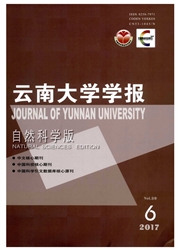

 中文摘要:
中文摘要:
用AMI半经验和密度泛函计算相结合的量子化学方法,计算了15种黄酮类化合物的解离焓(O-H BDE)和电离势(IP),以此为理论指标评价了这些化合物清除自由基的活性,并讨论了部分化合物抗氧化活性的构效关系.计算得到在非极性溶剂中3,7,8号化合物清除自由基活性最高,活性最低的是11,15号化合物;在极性溶剂中3,4,5号化合物清除自由基活性最高;可以得出,3号化合物(3,7,3’,4’-四羟基黄酮)无论在极性和非极性溶剂中均具有较强的清除自由基活性,提示其可能作为抗氧化、抗肿瘤、抗菌和抗病毒等药物的有效成分.
 英文摘要:
英文摘要:
A kind of combined quantum chemistry method (DFT/AM 1) is employed to calculate 0--H bond dissociation enthalpies (BDEs) and ionization potentials (IPs) of fifteen flavonoids, by which their antioxidative activities are evaluated, and the structure-antioxidative activity relationship of some of these compounds is discussed. It was found that in non-polar solvents compounds 3,7 and 8 have the highest activity, and compounds 11,15 have the lowest activity to scavenge free radicals. And in polar solvents compounds 3,4 and 5 have the highest activity to scavenge free radicals. It can be concluded that in polar and non-polar solvents compound 3 (3,7,3' ,4'-Tetrahydroxyflavone)has the highest activity to scavenge free radicals, suggesting that it is a potential efficient drug for anti-tumor, anti-bacteria and anti-virus.
 同期刊论文项目
同期刊论文项目
 同项目期刊论文
同项目期刊论文
 期刊信息
期刊信息
